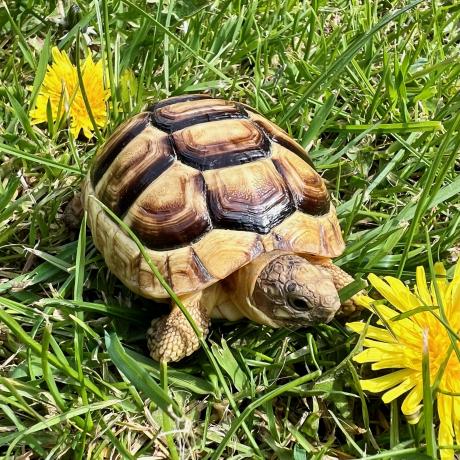

The Marginated Tortoise can only be found in parts of Greece and southern Albania, they have also been introduced in Sardinia and Tuscany, Italy.
The Marginated Tortoise is a medium size species which grows on average around 3–35cm and weigh up to 5kg. They have beautiful shell colouration, which contrasts between black and off white/yellow/beige, similar to the colour of a Hermann’s Tortoise. One easy way to tell the two apart is not only by their size but to look at the rear end of a Marginated tortoise. Their shell flares out, giving them the appearance of wearing a mini skirt. This is normal for this species and not something to worry about.
A healthy animal should have a solid, smooth domed shell with no pyramiding. They have a strong beak similar to birds, in order to eat the tough vegetation in their diet; often using their claws to hold food in place while they eat. Males will generally have longer tails than females, and as they grow larger the plastron (underside of the shell) will begin to concave to facilitate breeding.
The Marginated Tortoises geographic range includes mountainous regions of Southern Greece, Balkans,Italy and northeastern Sardinia.
The Marginated Tortoise will roam around the semi arid scrub and forests where they live, often searching for food and to bask in the early morning sun, using their flared shells to absorb heat.
Marginated tortoises do not do well housed in normal reptile type vivariums. The humidity levels can fluctuate dangerously (tortoises urinate profusely and love to tip water bowls over!) and it can be difficult to achieve the optimal temperature gradient. Housing your tortoise in a tortoise table (open top style enclosure) is the best option as it provides maximum air flow and allows the tortoise to thermoregulate more effectively. For this species a 4ft table should be the minimum for anywhere up to 6 years old - larger is better for this species.
We recommend using a combination of a dome fitting and a mercury vapor bulb to heat your tortoise table. These bulbs provide optimal levels of UVB, UVA, visual light and heat all in one bulb, something every tortoise needs! The other option is to use a separate Heat Bulb (controlled by a thermostat) and appropriate T5 UVB lighting strip. It is important that you check the basking temperature you will be providing with this equipment. The recommended basking spot temperature is around 28-34°C and down to 20°C on the cool end of the enclosure. They will generally require 12-14 hours daylight and at night, lights should be turned off. Most tortoises can be kept at room temperature, simulating the natural temperature drop they experience in the wild as the sun goes down. For particularly cold rooms, additional heating can be provided by adding a ceramic heat bulb connected to a thermostat set around 10 degrees cooler than the daytime basking temperatures. Ceramic bulbs do not emit any light, so the use of this will not interrupt the tortoises circadian rhythm in the same way as having bright basking bulbs on at night would.
For substrate we would recommend a soil based, tortoise specific bedding as it’s specifically designed to replicate the arid habitats where Marginated tortoises are from. Its texture and moisture retention replicates their environment perfectly, allowing the tortoise to dig and forage as they would in the wild. We recommend lightly misting the enclosure in the morning to simulate early morning dew, this will evaporate throughout the morning in a tortoise table.
Décor is important for this species. Not only does it make the environment look nice aesthetically, but it provides environmental enrichment for the tortoise, essential for its physical and mental wellbeing. Remember that tortoises need items such as shallow bark or rocks to climb over and plenty of plants to graze on as they would in the wild.
Tortoises require a spacious, but shallow pool to drink from and bathe in. Be prepared, they will readily defecate in this as tortoises are able to absorb a small amount of liquid via their cloaca; which in turn can stimulate a bowel movement!
In the wild Marginated tortoises diet mainly consists of herbaceous and succulent vegetation including grasses, cacti and flowers. We strongly urge you to forage for a good variety of the available reptile safe edible plants for your tortoise. By doing so, you will be providing your pet with the best nutritional balance that nature has to offer!
A tortoises natural wild diet consists of thousands of different plant species, each containing unique vitamins and minerals which contribute to the overall health of the tortoise. It is very important that you supplement the diet of your tortoise with calcium and vitamins to ensure they are getting the perfect balance. You can simply sprinkle the supplements over the top of the food you provide your tortoise- think of it as lightly seasoning the food! This is essential for all reptiles and helps to prevent a number of preventable conditions such as metabolic bone disease (soft, deformed bones and shells) Runny eyes, kidney and liver problems.
Many species of tortoise that are available today are subject to CITES (Convention on International Trade in Endangered Species) article 10 paperwork. This in a nutshell provides proof that these tortoises have not been illegally taken from the wild. This paperwork is essential if you intend to keep, sell or even breed your tortoise. Tortoise species covered under this act are known as Annex A.